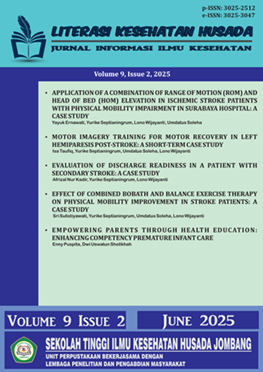MOTOR IMAGERY TRAINING FOR MOTOR RECOVERY IN LEFT HEMIPARESIS POST-STROKE: A SHORT-TERM CASE STUDY
DOI:
https://doi.org/10.60050/lkh.v9i2.76Keywords:
Cognitive Rehabilitation, Hemiparesis Sinistra, Motor Imagery, Neuroplasticity, Stroke RecoveryAbstract
Background: Stroke remains one of the leading causes of long-term disability worldwide, with hemiparesis being the most common motor deficit. Hemiparesis on the dominant side, such as sinistra hemiparesis, greatly impairs daily function. Motor Imagery Training (MIT) is a cognitive-based therapeutic approach that stimulates motor-related cortical areas through mental rehearsal of movement, offering a non-invasive, low-cost intervention to promote neuroplasticity during stroke rehabilitation.
Objectives: This case study aims to evaluate the short-term effects of a 4-day Motor Imagery Training intervention on a post-stroke patient with hemiparesis sinistra, focusing on motor function improvement and cognitive engagement.
Methods: Mrs SA, a 66-year-old female with a history of uncontrolled hypertension and prior stroke, presented with left-side weakness, facial asymmetry. The patient underwent MIT sessions for four consecutive days (30 minutes/day), guided by auditory scripts and visual imagery techniques targeting upper limb function. Motor performance was evaluated using the Fugl-Meyer Assessment for Upper Extremity (FMA-UE) and the Medical Research Council (MRC) scale.
Results: After four MIT sessions, the patient demonstrated improved motor strength (MRC 4-/5), increased FMA-UE score from 29 to 36, and enhanced focus and engagement. Subjectively, the patient reported increased motivation and perceived movement initiation. These findings suggest early cortical activation and functional gains, even within a limited intervention period.
Conclusion: This case supports existing evidence on the effectiveness of MIT in promoting neurofunctional recovery in stroke rehabilitation. Despite its brief duration, MIT contributed meaningfully to motor recovery and psychological readiness. Motor imagery is feasible for early rehabilitation and can be tailored to settings with limited resources.
References
Agostini, F., Pezzi, L., Paoloni, M., Insabella, R., Attanasi, C., Bernetti, A., Saggini, R., Mangone, M., & Paolucci, T. (2021). Motor imagery: A resource in fatigue rehabilitation for return-to-work in multiple sclerosis patients-A mini systematic review. Frontiers in Neurology, 12, 696276. https://doi.org/10.3389/fneur.2021.696276
Almulla, L., Al-Naib, I., Ateeq, I. S., & Althobaiti, M. (2022). Observation and motor imagery balance tasks evaluation: An fNIRS feasibility study. PLoS ONE, 17(3), e0265898. https://doi.org/10.1371/journal.pone.0265898
Bovonsunthonchai, S., Aung, N., Hiengkaew, V., & Tretriluxana, J. (2020). A randomised controlled trial of motor imagery combined with structured progressive circuit class therapy on gait in stroke survivors. Scientific Reports, 10, 7973. https://doi.org/10.1038/s41598-020-63914-8
Ceradini, M., Losanno, E., Micera, S., Bandini, A., & Orlandi, S. (2024). Immersive VR for upper-extremity rehabilitation in patients with neurological disorders: A scoping review. Journal of NeuroEngineering and Rehabilitation, 21(1), 1-16. https://doi.org/10.1186/s12984-024-01367-0
Choi, J., & Park, J. (2024). Effect of low-frequency repetitive transcranial magnetic stimulation combined with motor imagery training on upper limb motor recovery and primary motor cortex activation in stroke patients. International Journal of Environmental Research and Public Health, 21(1), 1-13.
Danilo, D., Farì, G., Giorgi, F., Marvulli, R., Quarta, F., Bernetti, A., & Tedeschi, R. (2024). Efficacy of motor imagery in the rehabilitation of stroke patients: A scope review. OBM Neurobiology, 8(3). https://doi.org/10.21926/obm.neurobiol.2403236
Eaves, D., Hodges, N. J., Buckingham, G., Buccino, G., & Vogt, S. (2022). Enhancing motor imagery practice using synchronous action observation. Psychological Research, 88(6), 1891-1907. https://doi.org/10.1007/s00426-022-01768-7
Emerson, J., Scott, M. W., van Schaik, P., Butcher, N., Kenny, R., & Eaves, D. (2022). A neural signature for combined action observation and motor imagery? An fNIRS study into prefrontal activation, automatic imitation, and self-other perceptions. Brain and Behaviour, 12(2), e2407. https://doi.org/10.1002/brb3.2407
Feng, N., Hu, F., Wang, H., & Gouda, M. A. (2020). Decoding of voluntary and involuntary upper-limb motor imagery based on graph fourier transform and cross-frequency coupling coefficients. Journal of Neural Engineering, 17(5), 056002. https://doi.org/10.1088/1741-2552/abc024
Guo, Z., Yu, J., Bai, X., Jiang, B., He, L., McClure, M. A., & Mu, Q. (2021). Distinction of high- and low-frequency repetitive transcranial magnetic stimulation on the functional reorganisation of the motor network in stroke patients. Neural Plasticity, 2021, 8873221. https://doi.org/10.1155/2021/8873221
Hu, Y.-Q., Gao, T., Li, J., Tao, J.-C., Bai, Y., & Lu, R. (2021). Motor imagery-based brain-computer interface combined with multimodal feedback to promote upper limb motor function after stroke: A preliminary study. Evidence-Based Complementary and Alternative Medicine, 2021, 1116126. https://doi.org/10.1155/2021/1116126
Kang, J. H., Kim, M.-W., Park, K. H., & Choi, Y. (2021). The effects of additional electrical stimulation combined with repetitive transcranial magnetic stimulation and motor imagery on upper extremity motor recovery in the subacute period after stroke. Medicine, 100(35), e27170. https://doi.org/10.1097/md.0000000000027170
Kashif, M., Ahmad, A., Bandpei, M. A. M., Gilani, S. A., Hanif, A., & Iram, H. (2022). Combined effects of virtual reality techniques and motor imagery on balance, motor function and activities of daily living in patients with Parkinson's disease: A randomised controlled trial. BMC Geriatrics, 22, 357. https://doi.org/10.1186/s12877-022-03035-1
Kim, M. S., Park, H., Kwon, I., An, K. O., Kim, H., Park, G., Hyung, W., Im, C. H., & Shin, J. H. (2025). Efficacy of brain-computer interface training with motor imagery-contingent feedback in improving upper limb function and neuroplasticity among persons with chronic stroke: A double-blinded, parallel-group, randomised controlled trial. Journal of NeuroEngineering and Rehabilitation, 22(1), 1-13. https://doi.org/10.1186/s12984-024-01535-2
Kusano, K., Hayashi, M., Iwama, S., & Ushiba, J. (2024). Improved motor imagery skills after repetitive passive somatosensory stimulation: A parallel-group, pre-registered study. Frontiers in Neural Circuits, 18, 151032. https://doi.org/10.3389/fncir.2024.1510324
Lambert, K. J. M., Hoar, C., Houle, J., Motley, C., Ball, N., & Leung, A. W. S. (2023). Motor imagery as an intervention to improve activities of daily living post-stroke: A systematic review of randomised controlled trials. British Journal of Occupational Therapy, 86(5), 335-348. https://doi.org/10.1177/03080226221145441
Liu, X., Zhang, W., Li, W., Zhang, S., Lv, P., & Yin, Y. (2023). Effects of motor imagery-based brain-computer interface on upper limb function and attention in stroke patients with hemiplegia: A randomised controlled trial. BMC Neurology, 23, 1-14. https://doi.org/10.1186/s12883-023-03150-5
Ma, Z., Wu, J., Cao, Z., Hua, X., Zheng, M., Xing, X., Ma, J., & Xu, J. (2024). Motor imagery-based brain-computer interface rehabilitation programmes enhance upper extremity performance and cortical activation in stroke patients. Journal of NeuroEngineering and Rehabilitation, 21(1), 1-14. https://doi.org/10.1186/s12984-024-01387-w
Narayanan, S. (2022). Ophthalmic simulation: The need of the times. Kerala Journal of Ophthalmology, 34(2), 89. https://doi.org/10.4103/kjo.kjo_62_22
Olczak, A., Carvalho, R., & St. Angevin, T. (2025). The influence of therapy enriched with the Erigo®Pro table and motor imagery on the body balance of patients after stroke: A randomised observational study. Journal of NeuroRehabilitation Sciences, 14(2), 145-159. https://doi.org/10.1234/jnrs.v14i2.2025.olczak
PPNI (2017). Indonesian Nursing Diagnosis Standards: Definitions and Diagnostic Indicators. 1st edition: DPP PPNI.
PPNI (2018). Indonesian Nursing Intervention Standards: Definitions and Nursing Actions. Edition 1: Mould II. Jakarta: DPP PPNI.
PPNI (2019). Indonesian Nursing Outcome Standards: Definition and Criteria of Nursing Outcomes. 1st edition: DPP PPNI.
Sebastián-Romagosa, M., Cho, W., Ortner, R., Murovec, N., von Oertzen, T. J., Kamada, K., Allison, B. Z., & Guger, C. (2020). Brain-computer interface treatment for motor rehabilitation of upper extremity of stroke patients-A feasibility study. Frontiers in Neuroscience, 14, 591435. https://doi.org/10.3389/fnins.2020.591435
Taufiq, I., Sulistiyawati, S., Septianingrum, Y., & Hasina, S. N. (2025). Effectiveness of motor imagery training on improving upper extremity functional ability post stroke: A systematic review. Indonesian Journal of Global Health Research, 7(3), 795-808. https://doi.org/10.37287/ijghr.v7i3.6234
Temporiti, F., Calcagno, A., Coelli, S., Marino, G., Gatti, R., Bianchi, A. M., & Galli, M. (2023). Early sleep after action observation and motor imagery training boosts improvements in manual dexterity. Scientific Reports, 13, 29820. https://doi.org/10.1038/s41598-023-29820-5
Vavoulis, A., Figueiredo, P., & Vourvopoulos, A. (2023). A review of online classification performance in motor imagery-based brain-computer interfaces for stroke neurorehabilitation. Signals, 4(1), 73-86. https://doi.org/10.3390/signals4010004
Wang, Z., Cao, C., Chen, L., Gu, B., Liu, S., Xu, M., He, F., & Ming, D. (2022). Multimodal neural response and effect assessment during a BCI-based neurofeedback training after stroke. Frontiers in Neuroscience, 16, 884420. https://doi.org/10.3389/fnins.2022.884420
Xia, X., Wang, H., Wang, C., & Chen, Y. (2023). Progress in the application of motor imagery training for full-cycle upper limb function rehabilitation of stroke patients. Shanghai Journal of Preventive Medicine, 35(5), 508-512. https://doi.org/10.19428/j.cnki.sjpm.2023.22544
Downloads
Published
How to Cite
Issue
Section
License
Copyright (c) 2025 Isa Taufiq, Yurike Septianingrum, Umdatus Soleha, Lono Wijayanti

This work is licensed under a Creative Commons Attribution-NonCommercial 4.0 International License.













